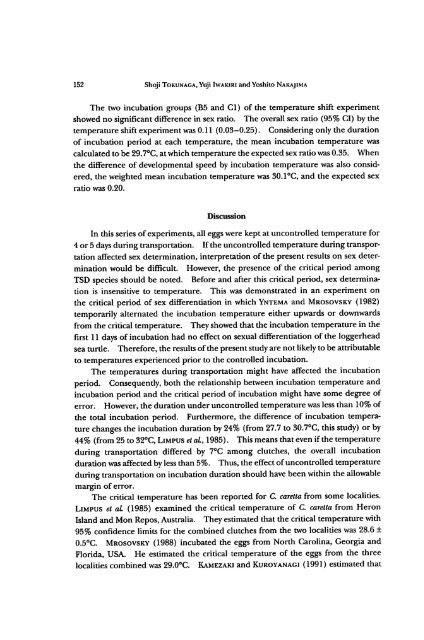Temperature-dependent Sex Determination of a Sea Turde, Caretta ...
Temperature-dependent Sex Determination of a Sea Turde, Caretta ...
Temperature-dependent Sex Determination of a Sea Turde, Caretta ...
Create successful ePaper yourself
Turn your PDF publications into a flip-book with our unique Google optimized e-Paper software.
152 Shoji Tokunaga, Yuji Iwakiri and Yoshito Nakajima<br />
The two incubation groups (B5 and CI) <strong>of</strong> the temperature shift experiment<br />
showed no significant difference in sex ratio. The overallsex ratio (95% CI) by the<br />
temperature shift experiment was 0.11 (0.03-0.25). Considering only the duration<br />
<strong>of</strong> incubation period at each temperature, the mean incubation temperature was<br />
calculated to be 29.7°C,at which temperature the expected sex ratio was0.35. When<br />
the difference <strong>of</strong> developmental speed by incubation temperature was also consid<br />
ered, the weighted mean incubation temperature was 30.1°C, and the expected sex<br />
ratio was 0.20.<br />
Discussion<br />
In this series <strong>of</strong> experiments, all eggswere kept at uncontrolled temperature for<br />
4 or 5 daysduring transportation. If the uncontrolled temperature during transpor<br />
tation affected sex determination, interpretation <strong>of</strong> the present results on sex deter<br />
mination would be difficult. However, the presence <strong>of</strong> the critical period among<br />
TSD species should be noted. Before and after this critical period, sex determina<br />
tion is insensitive to temperature. This was demonstrated in an experiment on<br />
the critical period <strong>of</strong> sex differentiation in whichYntema and Mrosovsky (1982)<br />
temporarily alternated the incubation temperature either upwards or downwards<br />
from the critical temperature. Theyshowed that the incubation temperature in the<br />
first 11 days <strong>of</strong> incubation had no effecton sexual differentiation <strong>of</strong> the loggerhead<br />
sea turde. Therefore, the results <strong>of</strong> the present studyare not likelyto be attributable<br />
to temperatures experienced prior to the controlled incubation.<br />
The temperatures during transportation might have affected the incubation<br />
period. Consequently, both the relationship between incubation temperature and<br />
incubation period and the critical period <strong>of</strong> incubation might have some degree <strong>of</strong><br />
error. However, the duration under uncontrolled temperature waslessthan 10% <strong>of</strong><br />
the total incubation period. Furthermore, the difference <strong>of</strong> incubation tempera<br />
ture changes the incubation duration by 24% (from 27.7 to 30.7°C, thisstudy) or by<br />
44% (from 25 to 32°C,Limpus etal, 1985). This means that even if the temperature<br />
during transportation differed by 7°C among clutches, the overall incubation<br />
duration was affected bylessthan 5%. Thus, the effect<strong>of</strong> uncontrolled temperature<br />
duringtransportation on incubation duration should have beenwithin the allowable<br />
margin <strong>of</strong> error.<br />
The critical temperature has been reported for C. caretta from some localities.<br />
Limpus et al (1985) examined the critical temperature <strong>of</strong> C. caretta from Heron<br />
Island and Mon Repos, Australia. They estimated that the critical temperature with<br />
95% confidence limits for the combined clutches from the two localities was 28.6 ±<br />
0.5°C. Mrosovsky (1988) incubated the eggs from North Carolina, Georgia and<br />
Florida, USA. He estimated the critical temperature <strong>of</strong> the eggs from the three<br />
localities combined was 29.0°C. Kamezaki and Kuroyanagi (1991) estimated that
















